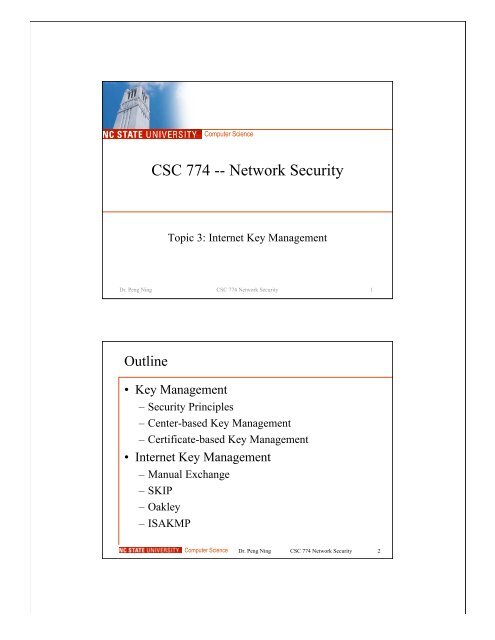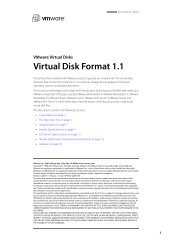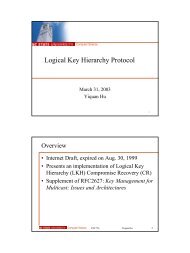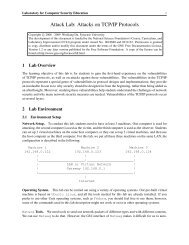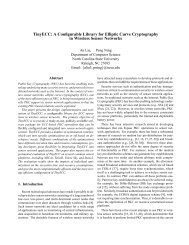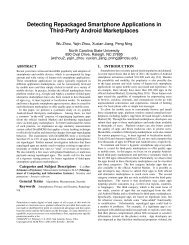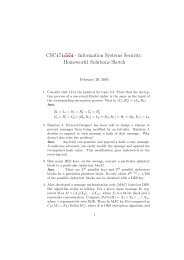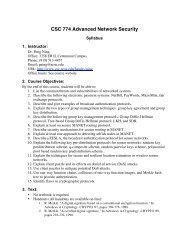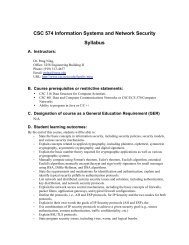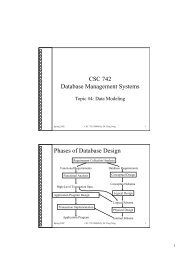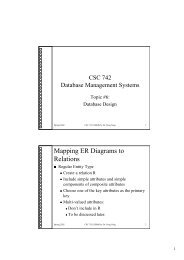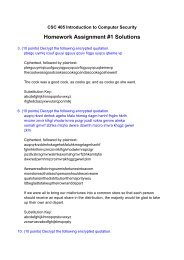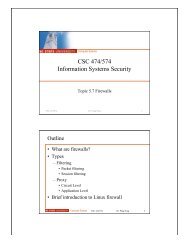CSC 774 -- Network Security - Dr. Peng Ning
CSC 774 -- Network Security - Dr. Peng Ning
CSC 774 -- Network Security - Dr. Peng Ning
You also want an ePaper? Increase the reach of your titles
YUMPU automatically turns print PDFs into web optimized ePapers that Google loves.
Computer Science<br />
<strong>CSC</strong> <strong>774</strong> -- <strong>Network</strong> <strong>Security</strong><br />
Topic 3: Internet Key Management<br />
<strong>Dr</strong>. <strong>Peng</strong> <strong>Ning</strong> <strong>CSC</strong> <strong>774</strong> <strong>Network</strong> <strong>Security</strong> 1<br />
Outline<br />
• Key Management<br />
– <strong>Security</strong> Principles<br />
– Center-based Key Management<br />
– Certificate-based Key Management<br />
• Internet Key Management<br />
– Manual Exchange<br />
– SKIP<br />
– Oakley<br />
– ISAKMP<br />
Computer Science<br />
<strong>Dr</strong>. <strong>Peng</strong> <strong>Ning</strong> <strong>CSC</strong> <strong>774</strong> <strong>Network</strong> <strong>Security</strong> 2
Key Management<br />
• Why do we need Internet key management<br />
– AH and ESP require encryption and authentication<br />
keys<br />
• Process to negotiate and establish IPsec SAs<br />
between two entities<br />
Computer Science<br />
<strong>Dr</strong>. <strong>Peng</strong> <strong>Ning</strong> <strong>CSC</strong> <strong>774</strong> <strong>Network</strong> <strong>Security</strong> 3<br />
<strong>Security</strong> Principles<br />
• Basic security principle for session keys<br />
– Compromise of a session key<br />
• Doesn’t permit reuse of the compromised session key.<br />
• Doesn’t compromise future session keys and long-term<br />
keys.<br />
Computer Science<br />
<strong>Dr</strong>. <strong>Peng</strong> <strong>Ning</strong> <strong>CSC</strong> <strong>774</strong> <strong>Network</strong> <strong>Security</strong> 4
<strong>Security</strong> Principles (Cont’d)<br />
• Perfect forward secrecy (PFS)<br />
– Compromise of current keys (session key or longterm<br />
key) doesn’t compromise past session keys.<br />
– Concern for encryption keys but not for<br />
authentication keys.<br />
– Not really “perfect” in the same sense as perfect<br />
secrecy for one-time pad.<br />
Computer Science<br />
<strong>Dr</strong>. <strong>Peng</strong> <strong>Ning</strong> <strong>CSC</strong> <strong>774</strong> <strong>Network</strong> <strong>Security</strong> 5<br />
Review of IPsec<br />
IPsec module 1 IPsec module 2<br />
SPD<br />
SPD<br />
IKE<br />
IKE<br />
SAD<br />
IPsec<br />
SA<br />
IPsec<br />
SAD<br />
SPD: <strong>Security</strong> Policy Database; IKE: Internet Key Exchange;<br />
SA: <strong>Security</strong> Association; SAD: <strong>Security</strong> Association Database.<br />
Computer Science<br />
<strong>Dr</strong>. <strong>Peng</strong> <strong>Ning</strong> <strong>CSC</strong> <strong>774</strong> <strong>Network</strong> <strong>Security</strong> 6
Review of IPsec (Cont’d)<br />
• Two Protocols (Mechanisms)<br />
– Authentication Header (AH)<br />
– Encapsulating <strong>Security</strong> Payload (ESP)<br />
Computer Science<br />
<strong>Dr</strong>. <strong>Peng</strong> <strong>Ning</strong> <strong>CSC</strong> <strong>774</strong> <strong>Network</strong> <strong>Security</strong> 7<br />
IPsec Architecture (Cont’d)<br />
• Can be implemented in<br />
– Host or gateway<br />
• Can work in two Modes<br />
– Tunnel mode<br />
– Transport mode<br />
Computer Science<br />
<strong>Dr</strong>. <strong>Peng</strong> <strong>Ning</strong> <strong>CSC</strong> <strong>774</strong> <strong>Network</strong> <strong>Security</strong> 8
Tunnel Mode<br />
Encrypted Tunnel<br />
Gateway<br />
Gateway<br />
A<br />
Unencrypted<br />
Encrypted<br />
Unencrypted<br />
B<br />
New IP<br />
Header<br />
AH or ESP<br />
Header<br />
Orig IP<br />
Header<br />
TCP<br />
Data<br />
Computer Science<br />
<strong>Dr</strong>. <strong>Peng</strong> <strong>Ning</strong> <strong>CSC</strong> <strong>774</strong> <strong>Network</strong> <strong>Security</strong> 9<br />
Transport Mode<br />
A<br />
Encrypted/Authenticated<br />
B<br />
New IP<br />
Header<br />
AH or ESP<br />
Header<br />
TCP<br />
Data<br />
Computer Science<br />
<strong>Dr</strong>. <strong>Peng</strong> <strong>Ning</strong> <strong>CSC</strong> <strong>774</strong> <strong>Network</strong> <strong>Security</strong> 10
Internet Key Management<br />
• Manual key management<br />
– Mandatory<br />
– Useful when IPsec developers are debugging<br />
– Keys exchanged offline (phone, email, etc.)<br />
– Set up SPI and negotiate parameters<br />
Computer Science<br />
<strong>Dr</strong>. <strong>Peng</strong> <strong>Ning</strong> <strong>CSC</strong> <strong>774</strong> <strong>Network</strong> <strong>Security</strong> 11<br />
Internet Key Management (Cont’d)<br />
• Automatic key management<br />
– Two major competing proposals<br />
– Simple Key Management for Internet Protocols<br />
(SKIP)<br />
– ISAKMP/OAKLEY<br />
• Photuris<br />
– Ephemeral D-H + authentication + Cookie<br />
– The first to use cookie to thwart DOS attacks<br />
• SKEME (extension to Photuris)<br />
• Oakley (RFC 2412)<br />
• ISAKMP (RFC 2408)<br />
• ISAKMP/OAKLEY → IKE (RFC 2409)<br />
Computer Science<br />
<strong>Dr</strong>. <strong>Peng</strong> <strong>Ning</strong> <strong>CSC</strong> <strong>774</strong> <strong>Network</strong> <strong>Security</strong> 12
Automatic Key Management<br />
• Key distribution and management combined<br />
– SKIP<br />
• Key establishment protocol<br />
– Oakley<br />
• focus on key exchange<br />
• Key management<br />
– Internet <strong>Security</strong> Association & Key Management<br />
Protocol (ISAKMP)<br />
• Focus on SA and key management<br />
• Clearly separated from key exchange.<br />
Computer Science<br />
<strong>Dr</strong>. <strong>Peng</strong> <strong>Ning</strong> <strong>CSC</strong> <strong>774</strong> <strong>Network</strong> <strong>Security</strong> 13<br />
SKIP<br />
• Idea<br />
– IP is connectionless in nature<br />
– Using security association forces a pseudo session<br />
layer underneath IP<br />
– Proposal: use sessionless key establishment and<br />
management<br />
• Pre-distributed and authenticated D-H public key<br />
• Packet-specific encryption keys are included in the IP<br />
packets<br />
Computer Science<br />
<strong>Dr</strong>. <strong>Peng</strong> <strong>Ning</strong> <strong>CSC</strong> <strong>774</strong> <strong>Network</strong> <strong>Security</strong> 14
SKIP (Cont’d)<br />
Two types of keys:<br />
1. KEK<br />
2. Packet key<br />
Certificate<br />
repository<br />
Bob’s certificate<br />
Alice’s certificate<br />
Alice<br />
Bob<br />
K p encrypted with KEK.<br />
Payload encrypted with K p .<br />
Computer Science<br />
<strong>Dr</strong>. <strong>Peng</strong> <strong>Ning</strong> <strong>CSC</strong> <strong>774</strong> <strong>Network</strong> <strong>Security</strong> 15<br />
SKIP (Cont’d)<br />
• KEK should be changed periodically<br />
– Minimize the exposure of KEK<br />
– Prevent the reuse of compromised packet keys<br />
• SKIP’s approach<br />
– KEK = h (K AB , n), where h is a one-way hash<br />
function, K AB is the the long term key between A<br />
and B, and n is a counter.<br />
Computer Science<br />
<strong>Dr</strong>. <strong>Peng</strong> <strong>Ning</strong> <strong>CSC</strong> <strong>774</strong> <strong>Network</strong> <strong>Security</strong> 16
SKIP (Cont’d)<br />
• Limitations<br />
– No Perfect Forward Secrecy<br />
• Can be modified to provide PFS, but it will lose the<br />
sessionless property.<br />
– No concept of SA; difficult to work with the<br />
current IPsec architecture<br />
• Not the standard, but remains as an alternative.<br />
Computer Science<br />
<strong>Dr</strong>. <strong>Peng</strong> <strong>Ning</strong> <strong>CSC</strong> <strong>774</strong> <strong>Network</strong> <strong>Security</strong> 17<br />
Oakley<br />
• Oakley is a refinement of the basic Diffie-<br />
Hellman key exchange protocol.<br />
• Why need refinement<br />
– Resource clogging attack<br />
– Replay attack<br />
– Man-in-the-middle attack<br />
– Choice of D-H groups<br />
Computer Science<br />
<strong>Dr</strong>. <strong>Peng</strong> <strong>Ning</strong> <strong>CSC</strong> <strong>774</strong> <strong>Network</strong> <strong>Security</strong> 18
Resource Clogging Attack<br />
Busy<br />
computing<br />
Many bogus requests<br />
With false source IPs<br />
• Stopping requests is difficult<br />
– We need to provide services.<br />
• Ignoring requests is dangerous<br />
– Denial of service attacks<br />
Computer Science<br />
<strong>Dr</strong>. <strong>Peng</strong> <strong>Ning</strong> <strong>CSC</strong> <strong>774</strong> <strong>Network</strong> <strong>Security</strong> 19<br />
Resource Clogging Attack (Cont’d)<br />
• Counter measure<br />
– If we cannot stop bogus requests, at least we<br />
should know from where the requests are sent.<br />
– Cookies are used to thwart resource clogging<br />
attack<br />
• Thwart, not prevent<br />
Computer Science<br />
<strong>Dr</strong>. <strong>Peng</strong> <strong>Ning</strong> <strong>CSC</strong> <strong>774</strong> <strong>Network</strong> <strong>Security</strong> 20
Resource Clogging Attack (Cont’d)<br />
• Cookie<br />
– Each side sends a pseudo-random number, the<br />
cookie, in the initial message, which the other side<br />
acknowledges.<br />
– The acknowledgement must be repeated in the<br />
following messages.<br />
– Do not begin D-H calculation until getting<br />
acknowledgement for the other side.<br />
Computer Science<br />
<strong>Dr</strong>. <strong>Peng</strong> <strong>Ning</strong> <strong>CSC</strong> <strong>774</strong> <strong>Network</strong> <strong>Security</strong> 21<br />
Requirements for cookie generation<br />
• The cookie must depend on the specific<br />
parties.<br />
– Prevent an attacker from reusing cookies.<br />
• Impossible to forge<br />
– Use secret values<br />
• Efficient<br />
• Cookies are also used for key naming<br />
– Each key is uniquely identified by the initiator’s<br />
cookie and the responder’s cookie.<br />
Computer Science<br />
<strong>Dr</strong>. <strong>Peng</strong> <strong>Ning</strong> <strong>CSC</strong> <strong>774</strong> <strong>Network</strong> <strong>Security</strong> 22
Replay Attack<br />
• Counter measure<br />
– Use nonce<br />
4. Busy<br />
computing<br />
1. Cookie exchange<br />
2. Later exchange<br />
Observe<br />
3. Replay<br />
Computer Science<br />
<strong>Dr</strong>. <strong>Peng</strong> <strong>Ning</strong> <strong>CSC</strong> <strong>774</strong> <strong>Network</strong> <strong>Security</strong> 23<br />
Man-in-the-middle-attack<br />
• Counter measure<br />
– Authentication<br />
– Depend on other mechanisms.<br />
• Pre-shared key.<br />
• Public key certificates.<br />
Computer Science<br />
<strong>Dr</strong>. <strong>Peng</strong> <strong>Ning</strong> <strong>CSC</strong> <strong>774</strong> <strong>Network</strong> <strong>Security</strong> 24
Oakley Groups<br />
• 0 no group (placeholder or non-DH)<br />
• 1 MODP, 768-bit modulus<br />
• 2 MODP, 1024-bit modulus<br />
• 3 MODP, 1536-bit modulus<br />
• 4 EC2N over GF(2 155 )<br />
• 5 EC2N over GF(2 185 )<br />
Computer Science<br />
<strong>Dr</strong>. <strong>Peng</strong> <strong>Ning</strong> <strong>CSC</strong> <strong>774</strong> <strong>Network</strong> <strong>Security</strong> 25<br />
Ephemeral Diffie-Hellman<br />
Short-term public key<br />
Short-term public key<br />
• Session key is computed on the basis of short-term<br />
DH public-private keys.<br />
• Exchange of these short-term public keys requires<br />
authentication and integrity.<br />
– Digital signatures.<br />
– Keyed message digests.<br />
• The only protocol known to support Perfect Forward<br />
Secrecy.<br />
Computer Science<br />
<strong>Dr</strong>. <strong>Peng</strong> <strong>Ning</strong> <strong>CSC</strong> <strong>774</strong> <strong>Network</strong> <strong>Security</strong> 26
Ephemeral Diffie-Hellman<br />
• Question: What happens if the long term key is<br />
compromised<br />
Computer Science<br />
<strong>Dr</strong>. <strong>Peng</strong> <strong>Ning</strong> <strong>CSC</strong> <strong>774</strong> <strong>Network</strong> <strong>Security</strong> 27<br />
ISAKMP<br />
• Oakley<br />
– Key exchange protocol<br />
– Developed to use with ISAKMP<br />
• ISAKMP<br />
– <strong>Security</strong> association and key management protocol<br />
– Defines procedures and packet formats to establish,<br />
negotiate, modify, and delete security associations.<br />
– Defines payloads for security association, key<br />
exchange, etc.<br />
Computer Science<br />
<strong>Dr</strong>. <strong>Peng</strong> <strong>Ning</strong> <strong>CSC</strong> <strong>774</strong> <strong>Network</strong> <strong>Security</strong> 28
ISAKMP Message<br />
• Fixed format header<br />
– 64 bit initiator and responder cookies<br />
– Exchange type (8 bits)<br />
– Next payload type (8 bits)<br />
– Flags: encryption, commit, authentication, etc.<br />
– 32 bit message ID<br />
• Resolve multiple phase 2 SAs being negotiated simultaneously<br />
– Variable number of payloads<br />
• Each has a generic header with<br />
– Payload boundaries<br />
– Next payload type (possible none)<br />
Computer Science<br />
<strong>Dr</strong>. <strong>Peng</strong> <strong>Ning</strong> <strong>CSC</strong> <strong>774</strong> <strong>Network</strong> <strong>Security</strong> 29<br />
ISAKMP Formats<br />
Computer Science<br />
<strong>Dr</strong>. <strong>Peng</strong> <strong>Ning</strong> <strong>CSC</strong> <strong>774</strong> <strong>Network</strong> <strong>Security</strong> 30
ISAKMP Phases<br />
• Phase 1<br />
– Establish ISAKMP SA to protect further ISAKMP<br />
exchanges<br />
– Or use pre-established ISAKMP SA<br />
– ISAKMP SA identified by initiator cookie and<br />
responder cookie<br />
• Phase 2<br />
– Negotiate security services in SA for target<br />
security protocol or application.<br />
Computer Science<br />
<strong>Dr</strong>. <strong>Peng</strong> <strong>Ning</strong> <strong>CSC</strong> <strong>774</strong> <strong>Network</strong> <strong>Security</strong> 31<br />
ISAKMP<br />
• Disadvantage<br />
– Additional overhead due to 2 phases<br />
• Advantages<br />
– Same ISAKMP SA can be used to negotiate phase<br />
2 for multiple protocols<br />
– ISAKMP SA can be used to facilitate maintenance<br />
of SAs.<br />
– ISAKMP SA can simplify phase 2.<br />
Computer Science<br />
<strong>Dr</strong>. <strong>Peng</strong> <strong>Ning</strong> <strong>CSC</strong> <strong>774</strong> <strong>Network</strong> <strong>Security</strong> 32
ISAKMP Domain Of Interpretation (DOI)<br />
• DOI defines<br />
– Payload format<br />
– Exchange types<br />
– Naming conventions for security policies,<br />
cryptographic algorithms<br />
• DOI for IPsec has been defined.<br />
Computer Science<br />
<strong>Dr</strong>. <strong>Peng</strong> <strong>Ning</strong> <strong>CSC</strong> <strong>774</strong> <strong>Network</strong> <strong>Security</strong> 33<br />
ISAKMP Exchange Types<br />
• 0 none<br />
• 1 base<br />
• 2 identity protection<br />
• 3 authentication only<br />
• 4 aggressive<br />
• 5 informational<br />
• 6-31 reserved<br />
• 32-239 DOI specific use<br />
• 240-255 private use<br />
Computer Science<br />
<strong>Dr</strong>. <strong>Peng</strong> <strong>Ning</strong> <strong>CSC</strong> <strong>774</strong> <strong>Network</strong> <strong>Security</strong> 34
ISAKMP Exchange Types<br />
• Base exchange<br />
– reveals identities<br />
• Identity protection exchange<br />
– Protects identities at cost of extra messages.<br />
• Authentication only exchange<br />
– No key exchange<br />
• Aggressive exchange<br />
– Reduce number of message, but reveals identity<br />
• Informational exchange<br />
– One-way transmission of information.<br />
Computer Science<br />
<strong>Dr</strong>. <strong>Peng</strong> <strong>Ning</strong> <strong>CSC</strong> <strong>774</strong> <strong>Network</strong> <strong>Security</strong> 35<br />
ISAKKMP Payload Types<br />
• 0<br />
none<br />
• 1 SA security association<br />
• 2 P proposal<br />
• 3 T transform<br />
• 4 KE key exchange<br />
• 5 ID identification<br />
• 6 CERT certificate<br />
• 7 CR certificate request<br />
Computer Science<br />
<strong>Dr</strong>. <strong>Peng</strong> <strong>Ning</strong> <strong>CSC</strong> <strong>774</strong> <strong>Network</strong> <strong>Security</strong> 36
ISAKKMP Payload Types<br />
• 8 H hash<br />
• 9 SIG signature<br />
• 10 NONCE nonce<br />
• 11 N notification<br />
• 12 D delete<br />
• 13 VID vender ID<br />
• 14-127 reserved<br />
• 128-255 private use<br />
Computer Science<br />
<strong>Dr</strong>. <strong>Peng</strong> <strong>Ning</strong> <strong>CSC</strong> <strong>774</strong> <strong>Network</strong> <strong>Security</strong> 37<br />
ISAKMP Payload Types<br />
Computer Science<br />
<strong>Dr</strong>. <strong>Peng</strong> <strong>Ning</strong> <strong>CSC</strong> <strong>774</strong> <strong>Network</strong> <strong>Security</strong> 38
ISAKMP Exchanges<br />
Basic Exchange<br />
1. I→R: SA; NONCE<br />
2. R→I: SA; NONCE<br />
3. I→R: KE; ID I ; AUTH<br />
4. R→I: KE; ID R ; AUTH<br />
• Begin ISAKMP-SA<br />
negotiation<br />
• Basic SA agreed upon<br />
• Key generated; Initiator id<br />
verified by responder<br />
• Responder id verified by<br />
initiator; key generated; SA<br />
established<br />
Computer Science<br />
<strong>Dr</strong>. <strong>Peng</strong> <strong>Ning</strong> <strong>CSC</strong> <strong>774</strong> <strong>Network</strong> <strong>Security</strong> 39<br />
ISAKMP Exchanges (Cont’d)<br />
Identify Protection Exchange<br />
1. I→R: SA<br />
2. R→I: SA<br />
3. I→R: KE; NONCE<br />
4. R→I: KE; NONCE<br />
5. I→R: ID I ; AUTH<br />
6. R→I: ID R ; AUTH<br />
• Begin ISAKMP-SA<br />
negotiation<br />
• Basic SA agreed upon<br />
• Key generated;<br />
• key generated;<br />
• Initiator id verified by<br />
responder<br />
• Responder id verified by<br />
initiator; SA established<br />
Red messages: Payload encrypted after ISAKMP header<br />
Computer Science<br />
<strong>Dr</strong>. <strong>Peng</strong> <strong>Ning</strong> <strong>CSC</strong> <strong>774</strong> <strong>Network</strong> <strong>Security</strong> 40
ISAKMP Exchanges (Cont’d)<br />
Authentication Only Exchange<br />
1. I→R: SA; NONCE<br />
2. R→I: SA; NONCE; ID R ;<br />
AUTH<br />
3. I→R: ID I ; AUTH<br />
• Begin ISAKMP-SA<br />
negotiation<br />
• Basic SA agreed upon;<br />
Responder id verified by<br />
initiator<br />
• Initiator id verified by<br />
responder; SA established<br />
Computer Science<br />
<strong>Dr</strong>. <strong>Peng</strong> <strong>Ning</strong> <strong>CSC</strong> <strong>774</strong> <strong>Network</strong> <strong>Security</strong> 41<br />
ISAKMP Exchanges (Cont’d)<br />
Aggressive Exchange<br />
1. I→R: SA; KE; NONCE;<br />
ID I<br />
2. R→I: SA; KE; NONCE;<br />
ID R ; AUTH<br />
3. I→R: AUTH<br />
• Begin ISAKMP-SA<br />
negotiation and key<br />
exchange<br />
• Responder identity verified<br />
by responder; Key generated;<br />
Basic SA agreed upon;<br />
• Initiator id verified by<br />
responder; SA established<br />
Red messages: Payload encrypted after ISAKMP header<br />
Computer Science<br />
<strong>Dr</strong>. <strong>Peng</strong> <strong>Ning</strong> <strong>CSC</strong> <strong>774</strong> <strong>Network</strong> <strong>Security</strong> 42
ISAKMP Exchanges (Cont’d)<br />
Informational Exchange<br />
1. I→R: N/D • Error or status notification,<br />
or deletion.<br />
Red message: Payload encrypted after ISAKMP header<br />
Computer Science<br />
<strong>Dr</strong>. <strong>Peng</strong> <strong>Ning</strong> <strong>CSC</strong> <strong>774</strong> <strong>Network</strong> <strong>Security</strong> 43


